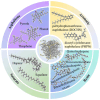Performance of Asphalt Materials Based on Molecular Dynamics Simulation: A Review
- PMID: 40808101
- PMCID: PMC12349307
- DOI: 10.3390/polym17152051
Performance of Asphalt Materials Based on Molecular Dynamics Simulation: A Review
Abstract
With the rising performance demands in road engineering, traditional experiments often fail to reveal the microscopic mechanisms behind asphalt behavior. Molecular dynamics (MD) simulation has emerged as a valuable complement, enabling molecular-level insights into asphalt's composition, structure, and aging mechanisms. This review summarizes the recent advances in applying MD to asphalt research. It first outlines molecular model construction approaches, including average models, three- and four-component systems, and modified models incorporating SBS, SBR, PU, PE, and asphalt-aggregate interfaces. It then analyzes how MD reveals the key performance aspects-such as high-temperature stability, low-temperature flexibility, self-healing behavior, aging processes, and interfacial adhesion-by capturing the molecular interactions. While MD offers significant advantages, challenges remain: idealized modeling, high computational demands, limited chemical reaction simulation, and difficulties in multi-scale coupling. This paper aims to provide theoretical insights and methodological support for future studies on asphalt performance and highlights MD simulation as a promising tool in pavement material science.
Keywords: aging; asphalt binder; asphalt modifiers; interfacial adhesion; molecular dynamics simulation; molecular modeling; self-healing.
Conflict of interest statement
The authors declare that they have no known competing financial interests or personal relationships that could have appeared to influence the work reported in this paper.
Figures


































Similar articles
-
A Study on the Road Performance of the Self-Healing Microcapsule for Asphalt Pavement.Materials (Basel). 2025 Jul 25;18(15):3483. doi: 10.3390/ma18153483. Materials (Basel). 2025. PMID: 40805361 Free PMC article.
-
Microscopic Mechanism of Asphalt Mixture Reinforced by Polyurethane and Silane Coupling Agent: A Molecular Dynamics Simulation-Based Study.Polymers (Basel). 2025 Jun 9;17(12):1602. doi: 10.3390/polym17121602. Polymers (Basel). 2025. PMID: 40574130 Free PMC article.
-
Health impacts of asphalt emissions: Examining neurological risks and the need for long-term exposure mitigation.J Hazard Mater. 2025 Mar 15;486:136849. doi: 10.1016/j.jhazmat.2024.136849. Epub 2024 Dec 14. J Hazard Mater. 2025. PMID: 39724706
-
A systematic review on sustainable utilization of plastic waste in asphalt: assessing environmental and health impact, performance, and economic viability.Environ Sci Pollut Res Int. 2024 Nov;31(54):62676-62701. doi: 10.1007/s11356-024-35395-z. Epub 2024 Nov 2. Environ Sci Pollut Res Int. 2024. PMID: 39487917
-
Viability of using high reclaimed asphalt pavement (RAP) contents incorporating waste materials for eco-friendly paving applications: a systematic review.Environ Sci Pollut Res Int. 2025 Jun;32(26):15493-15517. doi: 10.1007/s11356-025-36614-x. Epub 2025 Jun 19. Environ Sci Pollut Res Int. 2025. PMID: 40537705 Review.
References
-
- Feng D., Cao J., Gao L., Yi J. Recent developments in asphalt-aggregate separation technology for reclaimed asphalt pavement. J. Road Eng. 2022;2:332–347. doi: 10.1016/j.jreng.2022.07.002. - DOI
-
- Wang Z., Zhou Y., Zhang J., Ji X., Zhan H. Molecular components and molecular modelling for asphalt: A review. Adv. Phys. Res. 2025;4:2400128. doi: 10.1002/apxr.202400128. - DOI
-
- Li H., Zhang Y., Zhou L., Feng Z., Sun J., Hao G., Li Z. Effect of rubber powder desulfurization on the compatibility between rubber and bitumen: Combination and insight of experiments and molecular dynamics simulation. Constr. Build. Mater. 2024;414:134966. doi: 10.1016/j.conbuildmat.2024.134966. - DOI
-
- Song Y., Xu H., Wu S., Xie J., Chen A., Lv Y., Cheng Y., Li Y. High-quality utilization of reclaimed asphalt pavement (RAP) in asphalt mixture with the enhancement of steel slag and epoxy asphalt. Constr. Build. Mater. 2024;445:137963. doi: 10.1016/j.conbuildmat.2024.137963. - DOI
-
- Du J., Gui Y., Fu C., Li G. Large-scale molecular dynamics simulation and aggregate behavior research on asphalt. Case Stud. Constr. Mater. 2024;21:e03749. doi: 10.1016/j.cscm.2024.e03749. - DOI
Publication types
Grants and funding
LinkOut - more resources
Full Text Sources

